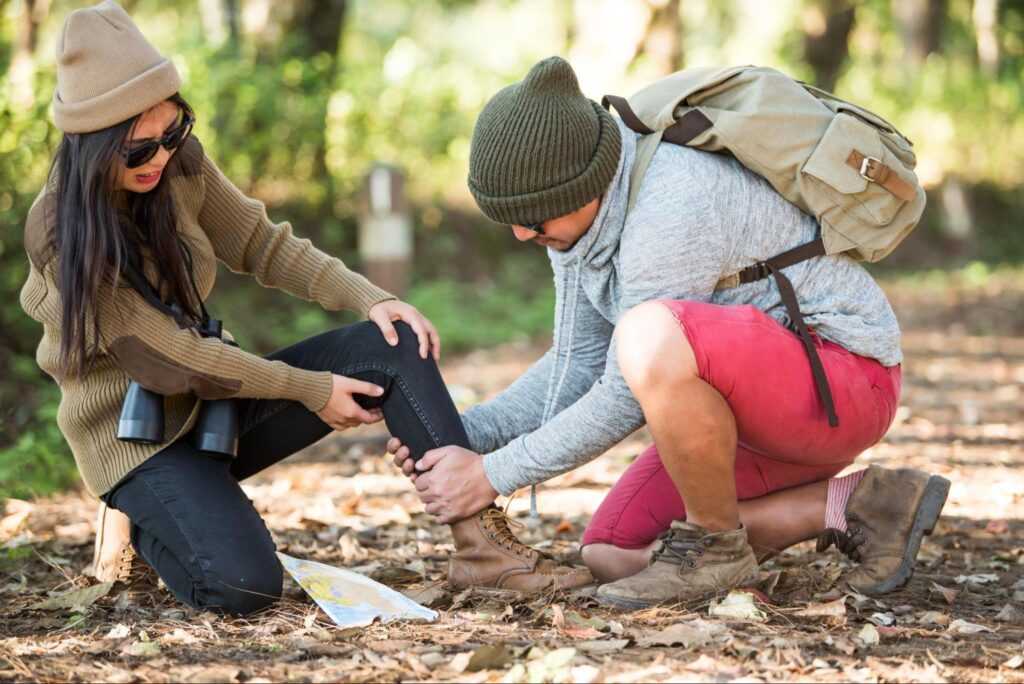The outdoors brings liberty and is ideal for adventure, but exploring nature and venturing off the beaten path can be unpredictable.
When you are in the wilderness, whether it is exploring, hiking, or camping, you have to be responsible for your own safety.
When injury strikes or worse, you find yourself in an emergency while far from civilization, it is vital to have a few first aid skills.
Today, weĺl discuss how to deal with common injuries, and best handle emergencies when help is hours away.
Situational Assessment
When an accident happens, there is a sense of urgency, and it can bring panic. However, it’s important to pause, breathe, and assess the situation, or you risk doing more harm than good.
Securing the Area Safely
You must check that you are somewhere safe enough to assist and administer aid before doing so.
If the terrain or weather is bad, you should move elsewhere. The last thing you want is a falling rock or a second injury making matters worse.
So, stop and evaluate your surroundings and consider moving the patient if it is safe to do so.
Perform A Primary Assessment
With the scene secure, you can make a primary assessment starting with your “ABCs”(Airways, Breathing, Circulation). This needs to be pretty swift, when every moment matters, stabilizing a patient and facilitating recovery.
How to Manage Common Injuries & Conditions
Sprains and soft tissue injuries account for 80% of injuries that occur when hiking. Without proper treatment, minor injuries sustained in the wilderness can become big problems when you’re miles from help.
Surface Wounds & Abrasions
Wounds in the wild need addressing as soon as possible. They should be cleaned with purified water or antiseptic wipes to prevent infection. They should be kept clean with a sterile dressing and bandage.
You also need to watch for the following signs of infection:
- Redness;
- Swelling;
- Pus.
Sprains, Fractures & Breaks
When you are in the wilderness, even a twisted ankle can be debilitating, reducing mobility substantially. A fracture or broken bone can be dangerous.
The limb needs immobilizing; you can fashion a trekking pole or rigid branch if necessary. Remember not to tie it too tightly and to use some sort of cushioning against the skin.
For sprains, remember the RICE acronym: Rest, Ice, Compression, and Elevation.
Treating Burns in the Wild
Campfires, outdoor cooking, or boiling water can be an accident waiting to happen.
Minor burns can be treated by cooling the area with clean, cold water for at least 10 minutes. The burn should then be covered with a sterile, non-adhesive dressing.
Remember that anything larger than the palm of your hand or serious burns requires immediate evacuation.
Emergency Situations in the Wild
If you face a medical emergency and you are far from professional help, the situation might become more critical.
When urgent intervention is required but unavailable, you need to know how to recognize and handle it.
Handling Hypothermia
If the body loses heat faster than it can produce it, then hypothermia can set in, and things can become critical. Below are the early warning signs.
- Shivering;
- Disorientation;
- Slurred speech.
In this situation, it is important to warm the core, make sure the person isn´t in wet clothing, and warm and dry them. Use sleeping bags and body heat, and focus on the chest, neck, and head areas.
High Temperature Dangers
Being too hot is as dangerous as being too cold; dehydration and heatstroke are no joke when out in the wilderness. The following symptoms are early signs:
- Confusion;
- Headache;
- Nausea;
- Lack of perspiration;
- Vomiting.
If you suspect either, keep the person shaded, cool them with water-soaked cloths, and remember to rehydrate slowly. An electrolyte solution can be a lifesaver. If symptoms worsen, then evacuation might be the only solution.
Allergies & Anaphylaxis
With plants and insects galore, allergic reactions are all too common.
Mild reactions can often be managed with antihistamines, but anaphylaxis requires epinephrine and rapid evacuation.
Breathing should be monitored, and CPR may be required.
Navigating Challenges in The Wild
Sometimes the standard solutions don´t work, and other strategies are required. Here are some things to consider to help navigate challenges in the wilderness.
Communication Tips
While phones might be out of coverage, you might want to consider using satellite messengers or personal locator beacons (PLBs).
If you need to send signals for help, basic signaling with mirrors can help alert those around.
You can create SOS ground signals and smoke signals with fires.
Good advice is to tell someone your planned location before leaving and to wear bright reflective clothing.
Having to improvise on the fly
Clothing, sticks, tarps, and backpacks can be repurposed into stretchers and splints should you find yourself in an emergency. ‘Be sure to practice a few knots, they can be a lifesaver when things don’t go to plan.
Leveraging Digital Resources
Digital maps, manuals, and emergency contacts, stored on devices, can also be lifesaving.
Although you may be far from a signal, should you manage to get hold of any public wifi, remember that a VPN can help keep your data and privacy safe. Check out what a VPN can do for you.
First Aid Kit Essentials in the Wilderness
The best defense for a trip in the wilderness is preparedness. So be sure to pack a well-stocked first aid kit to cope with whatever you might encounter.
Basics
A basic kit should include the following:
- A variety of adhesive and non-adhesive bandages;
- Gauze and medical tape;
- Antiseptic wipes;
- Tweezers and nail scissors;
- Moleskine for blisters;
- Pain relief such as paracetemol and ibuprofen;
- Gloves.
Adventurers Extras
If you are on an extended or remote trip, the following is wise:
- SAM splint;
- A thermal blanket;
- Antihistamines;
- Anti-diarrheal meds;
- Anti-nausea tablets;
- Electrolytes.
Conclusion
With professional help hours away, the best defense is to head out into the wild well-prepared.
It is wise to have a few first aid skills and a decent kit to hand, full of the essentials.
When you venture far from civilization, a minor mishap can become a major problem.
Fortunately, with the right judgment, knowledge, and tools, you can act fast, keep yourself safe, and enjoy the wild with peace of mind.


 Dominic Reed brings his extensive experience in outdoor survival and adventure sports to Terra Tactician Tactics, where he plays a crucial role in the platform's development. With a background in outdoor education and a deep love for wilderness exploration, Dominic is committed to creating content that inspires and informs readers. He specializes in writing articles on survival skills, advanced camping techniques, and gear recommendations, drawing from his own adventures and hands-on expertise. Dominic's practical approach and engaging storytelling help readers prepare for their outdoor pursuits, ensuring they are well-equipped for whatever nature throws their way.
In addition to his writing, Dominic actively collaborates with the team to expand the platform's reach and impact. He is passionate about connecting with the outdoor community and sharing his knowledge with those eager to learn more about survival tactics and adventure sports. His contributions have been instrumental in positioning Terra Tactician Tactics as a go-to resource for enthusiasts seeking to elevate their outdoor experiences. Dominic's dedication to the project is driven by his belief in the transformative power of nature and his desire to help others develop a deeper connection to the wild.
Dominic Reed brings his extensive experience in outdoor survival and adventure sports to Terra Tactician Tactics, where he plays a crucial role in the platform's development. With a background in outdoor education and a deep love for wilderness exploration, Dominic is committed to creating content that inspires and informs readers. He specializes in writing articles on survival skills, advanced camping techniques, and gear recommendations, drawing from his own adventures and hands-on expertise. Dominic's practical approach and engaging storytelling help readers prepare for their outdoor pursuits, ensuring they are well-equipped for whatever nature throws their way.
In addition to his writing, Dominic actively collaborates with the team to expand the platform's reach and impact. He is passionate about connecting with the outdoor community and sharing his knowledge with those eager to learn more about survival tactics and adventure sports. His contributions have been instrumental in positioning Terra Tactician Tactics as a go-to resource for enthusiasts seeking to elevate their outdoor experiences. Dominic's dedication to the project is driven by his belief in the transformative power of nature and his desire to help others develop a deeper connection to the wild.